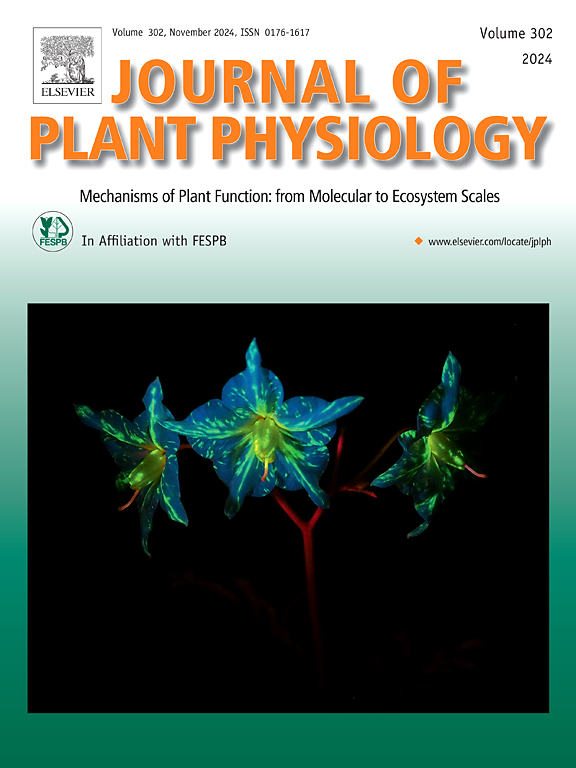两个小麦突变体降低株高的Rht1的鉴定及其对产量成分的影响。
IF 4
3区 生物学
Q1 PLANT SCIENCES
引用次数: 0
摘要
株高决定小麦抗倒伏能力,并与产量稳定性密切相关。本研究以冬小麦品种京411为野生型(WT),鉴定了两个半矮秆小麦突变体je0370和je0344。田间试验结果表明,这两个突变体的株高显著低于WT,千粒重je0370显著高于WT,而je0344显著低于WT。基于外显子组捕获测序的散装分离分析(BSA)表明,导致株高降低的基因位于4B染色体上。进一步的遗传连锁分析将矮秆基因定位在4B染色体29.26 ~ 48.61 Mb区间,对应的遗传距离为10.79 cM。该区域包含Rht1基因;随后,我们对je0370和je0344的Rht1基因进行了测序,并在190 bp的位置发现了C-T突变,导致两个突变体的DELLA结构域截断。利用Cleaved Amplified Polymorphic Sequences (CAPS)标记对F2群体进行进一步分析,发现纯合子Rht1突变显著降低了植株的株高和千粒重,而杂合子Rht1突变则表现为中间效应。然而,突变对小穗数、有效穗数和穗长没有显著影响。这些结果表明,Rht1突变是导致植株矮化和粒重减少的主要原因,但对其他产量成分没有实质性影响。该研究为Rht1在小麦育种中的应用提供了宝贵的见解。本文章由计算机程序翻译,如有差异,请以英文原文为准。
Identification of Rht1 for plant height reduction in two wheat mutants and the effects on yield components
Plant height determines lodging resistance and is closely linked to yield stability in wheat. In this study, we identified two semi-dwarf wheat mutants, designated je0370 and je0344, using the winter wheat cultivar Jing411 as the wild type (WT). Field experiments revealed that the plant height of these two mutants was significantly lower than that of the WT. In contrast, the thousand-grain weight was significantly higher in je0370 but lower in je0344 compared to the WT. Bulk Segregant Analysis (BSA) based on exome capture sequencing indicated that the gene responsible for height reduction is located on chromosome 4B. Further genetic linkage analysis mapped the dwarf gene to the interval of 29.26–48.61 Mb on chromosome 4B, corresponding to a genetic distance of 10.79 cM. This region encompasses the Rht1 gene; we subsequently sequenced the Rht1 gene in je0370 and je0344 and identified a C-T mutation at position 190 bp, resulting in a truncation of the DELLA domain in both mutants. Further analysis using Cleaved Amplified Polymorphic Sequences (CAPS) markers in F2 populations demonstrated that plants with homozygous Rht1 mutations exhibited significantly reduced plant height and thousand-grain weight, while heterozygous plants displayed intermediate effects. However, the mutation did not significantly affect spikelet number, effective spike number, or spike length. These findings conclusively demonstrate that the Rht1 mutation is responsible for plant dwarfism and reduced grain weight, without substantial impacts on other yield components. This study provides invaluable insights into the utilization of Rht1 in wheat breeding.
求助全文
通过发布文献求助,成功后即可免费获取论文全文。
去求助
来源期刊

Journal of plant physiology
生物-植物科学
CiteScore
7.20
自引率
4.70%
发文量
196
审稿时长
32 days
期刊介绍:
The Journal of Plant Physiology is a broad-spectrum journal that welcomes high-quality submissions in all major areas of plant physiology, including plant biochemistry, functional biotechnology, computational and synthetic plant biology, growth and development, photosynthesis and respiration, transport and translocation, plant-microbe interactions, biotic and abiotic stress. Studies are welcome at all levels of integration ranging from molecules and cells to organisms and their environments and are expected to use state-of-the-art methodologies. Pure gene expression studies are not within the focus of our journal. To be considered for publication, papers must significantly contribute to the mechanistic understanding of physiological processes, and not be merely descriptive, or confirmatory of previous results. We encourage the submission of papers that explore the physiology of non-model as well as accepted model species and those that bridge basic and applied research. For instance, studies on agricultural plants that show new physiological mechanisms to improve agricultural efficiency are welcome. Studies performed under uncontrolled situations (e.g. field conditions) not providing mechanistic insight will not be considered for publication.
The Journal of Plant Physiology publishes several types of articles: Original Research Articles, Reviews, Perspectives Articles, and Short Communications. Reviews and Perspectives will be solicited by the Editors; unsolicited reviews are also welcome but only from authors with a strong track record in the field of the review. Original research papers comprise the majority of published contributions.
 求助内容:
求助内容: 应助结果提醒方式:
应助结果提醒方式:


